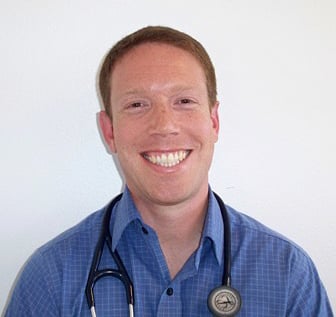Patient will present with → a 55-year-old female who comes to the clinic complaining of recurrent episodes of flushing, particularly on her face and neck, and diarrhea for the past six months. She notes that the flushing episodes last for about five minutes and are sometimes accompanied by a feeling of warmth and palpitations. Her medical history is unremarkable except for mild asthma. On physical examination, there are no abnormal findings except for slight wheezing on lung auscultation. Given her symptoms, a 24-hour urine test for 5-HIAA is ordered, which returns elevated. An abdominal CT scan reveals a small mass in the ileum and hepatic metastases.
To watch this and all of Joe-Gilboy PA-C's video lessons you must be a member. Members can log in here or join now.
"Symptoms of carcinoid syndrome can be memorized using the mnemonic FDR (flushing, diarrhea, and right-sided heart valves)."
A tumor arising from neuroendocrine cells → leading to excess secretion of serotonin, histamine, and bradykinin
- Common primary sites include GI (small and large intestines, stomach, pancreas, liver), lungs, ovaries, and thymus
- The most common site for a neuroendocrine (carcinoid) tumor to metastasize to is the liver
- Carcinoid tumor of the appendix is the most common cause. The appendiceal cancer travels from the appendix then to the liver, where it metastasizes to the lungs
- Usually asymptomatic until liver metastasis; symptoms develop occasionally
- GI tract tumor→ hormone secretion → enter into enterohepatic circulation → liver inactivates hormones → no symptoms
- Liver tumor → hormone secretion → released into circulation + liver dysfunction → symptoms
- Carcinoid syndrome (the hallmark sign) = Cutaneous flushing, diarrhea, wheezing and low blood pressure is actually quite rare and occurs in ~ 5% of carcinoid tumors and becomes manifest when vasoactive substances from the tumors enter the systemic circulation, escaping hepatic degradation.
- The syndrome includes flushing, ↑ intestinal motility (diarrhea), itching and less frequently, heart failure, vomiting, bronchoconstriction, asthma, and wheezing
- ↑ Serotonin leads to collagen fiber thickening, fibrosis = heart valve dysfunction → tricuspid regurgitation, pulmonary stenosis/bronchoconstriction, and wheezing
- ↑ Histamine and bradykinin = vasodilation and flushing
- ↑ serotonin synthesis → ↓ tryptophan → ↓ niacin/B3 synthesis = pellagra
CT-Scan to locate the tumors
- Octreoscan → radiolabeled somatostatin analog (octreotide) binds to somatostatin receptors on tumor cells
- Urinalysis → elevated 5-hydroxyindoleacetic acid (5-HIAA) → is the main metabolite of serotonin and is used to determine serotonin levels in the body
- Pellagra (niacin/B3 deficiency) - ↑ serotonin synthesis → ↓ tryptophan → ↓ niacin/B3 synthesis
- Chest X-ray shows low-grade CA seen as pedunculated sessile growth in the central bronchi
- Bronchoscopy- pink/purple central lesion, well-vascularized
Treatment is by surgical excision and carries a good prognosis
- The lesions are resistant to radiation therapy and chemotherapy
- Octreotide - a somatostatin analog that binds the somatostatin receptors and decreases the secretion of serotonin by the tumor
- Niacin supplementation
 Osmosis Osmosis |
|
 |
Lung carcinoma is typically divided into two categories, small cell carcinoma and non-small cell carcinoma. Non-small cell carcinoma subtypes include adenocarcinoma, squamous cell carcinoma, large cell carcinoma and carcinoid tumor. Bronchial carcinoid tumor is a neuroendocrine tumor that carries an excellent prognosis. It may be asymptomatic or may present with symptoms of bronchial obstruction such as coughing or hemoptysis. Occasionally, bronchial carcinoid tumors may cause carcinoid syndrome which is characterized by flushing, diarrhea, and wheezing. These tumors are chromogranin A positive and histology shows nests of neuroendocrine cells. Additionally, patients will have elevated urine 5-HIAA when carcinoid syndrome is present. Treatment includes surgical resection and octreotide for symptomatic relief.
Play Video + QuizQuestion 1 |
Cheilosis and stomatitis Hint: Riboflavin is an essential vitamin used in the production of flavin adenine dinucleotide and flavin mononucleotide. Symptoms of riboflavin deficiency include stomatitis, cheilosis, anemia, and itchy eyes. Riboflavin deficiency is common in developing countries but rare in developed countries with riboflavin fortified grain and rice products. | |
Confusion, ophthalmoplegia, and ataxia Hint: Wernicke encephalopathy is caused by a deficiency in thiamine and is particularly common in alcoholics. Wernicke is defined by the classic triad of confusion, ophthalmoplegia, and ataxia. In patients suspected of Wernicke encephalopathy, it is crucial to administer thiamine before glucose is given. | |
Swollen gums, bruising, and hemarthrosis Hint: Scurvy is a disease caused by a deficiency in vitamin C. Symptoms include swollen and bleeding gums, easy bruising, hemarthrosis, and neuropathy. Failure to treat scurvy will eventually lead to death. Vitamin C is found in vegetables and fruits such as kale, oranges, and lemons. | |
Dermatitis and mental status change | |
Ptosis, anhydrosis, and miosis Hint: Horner syndrome is a constellation of symptoms as a result of a lesion to the sympathetic chain. Symptoms include ipsilateral ptosis, anhydrosis, and miosis. Etiologies include multiple sclerosis, central nervous system tumors, and Pancoast tumors. |
References: Merck Manual · UpToDate


 Lecture
Lecture



